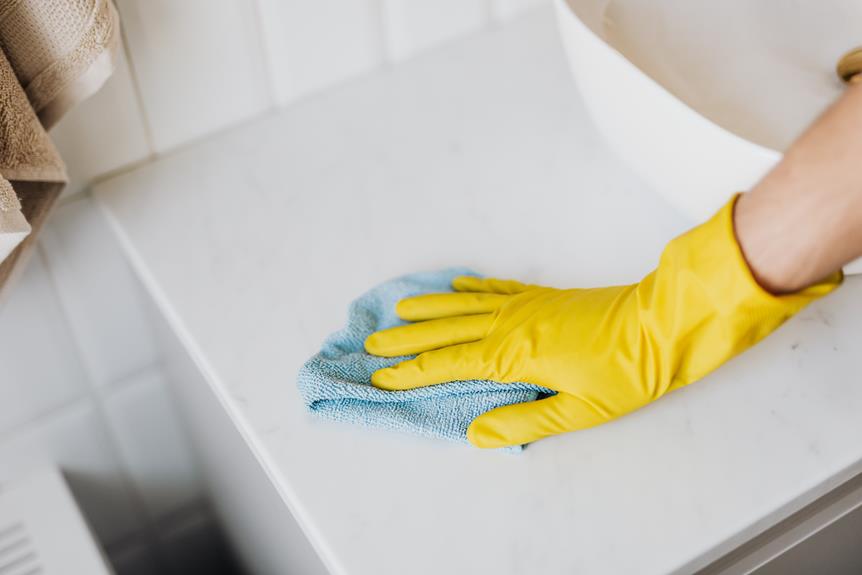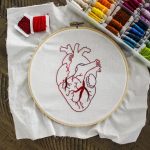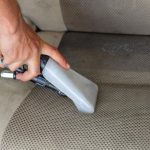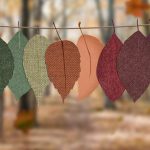Hey there!
So, you've found yourself in a sticky situation with glue on your favorite fabric, huh? Don't worry, we've got you covered.
Removing glue from fabric can feel like trying to untangle a knot, but with the right techniques, it's totally doable. From identifying the type of glue to pre-treating the stain and using solvent-based removers or natural remedies, we'll walk you through the process step by step.
By the end of this, you'll be a pro at banishing that stubborn glue from your fabric. So, let's roll up our sleeves and get started!
Key Takeaways
- Identify the type of glue by examining appearance and texture, considering glue application circumstances, and performing a compatibility test on a hidden area of the fabric.
- Pre-treat the stain by applying liquid laundry detergent, massaging it into the fabric, allowing it to sit, and rinsing with cold water. Consider using a pre-treatment stain remover for tough stains or delicate fabrics.
- Use solvent-based removers by applying them to the stain, ensuring proper ventilation, wearing gloves, and testing on a small area before applying.
- Employ natural remedies by creating a paste with baking soda and vinegar, applying it to the affected area, letting it sit, scrubbing gently, and rinsing with cold water. Repeat if necessary.
Identifying the Type of Glue
You can identify the type of glue on your fabric by examining its appearance, texture, and the circumstances of its application. Different types of glue leave distinct marks on fabric. For example, a white or yellowish residue could indicate the presence of wood glue, while a clear, rubbery substance might suggest the use of a fabric adhesive.
To differentiate between these types of glue, you can perform a simple test. First, analyze the appearance and texture of the residue. Then, consider the circumstances under which the fabric was glued. Was it exposed to moisture, heat, or chemicals?
Next, test the fabric compatibility by applying a small amount of water, heat, or solvent to a hidden area. By observing the fabric's reaction to these factors, you can gain valuable insights into the type of glue used.
Understanding these methods of identification and testing can help you determine the best approach for removing the glue from your fabric without causing damage.
Pre-Treating the Stain
Before attempting to remove the glue from your fabric, it's essential to pre-treat the stain to increase the effectiveness of the removal process. Using fabric-friendly pre-treatments can help break down the glue and make it easier to remove from the fabric fibers. One effective fabric-friendly pre-treatment is to apply a small amount of liquid laundry detergent directly to the stained area, gently massaging it into the fabric. Allow it to sit for a few minutes to penetrate the glue before rinsing with cold water.
Another option is to use a pre-treatment stain remover specifically designed for glue or adhesive stains. Apply the product according to the manufacturer's instructions and let it sit for the recommended time before laundering.
If the glue stain is particularly stubborn or if you're dealing with delicate or special fabrics, consider seeking professional cleaning services. Professional cleaners have the expertise and specialized products to effectively pre-treat and remove tough glue stains without causing damage to the fabric. They can also provide guidance on the best pre-treatment options for your specific fabric type, ensuring a successful removal process.
Using Solvent-Based Removers
To effectively remove glue from fabric, start by applying a solvent-based remover to the stained area using a clean cloth. Solvent-based removers can effectively break down and dissolve tough glue stains, but it's important to use them safely and ensure they're compatible with the fabric in question.
When using solvent-based removers, it's crucial to prioritize safety. Here's how to do it:
- Ventilation: Ensure you're working in a well-ventilated area to minimize inhalation of fumes.
- Skin Protection: Wear gloves to protect your skin from direct contact with the solvent.
- Read Labels: Always read the instructions and warnings on the solvent-based remover to understand its proper usage and safety precautions.
Additionally, consider fabric compatibility when using solvent-based removers. Some fabrics may be sensitive to certain solvents, so it's essential to:
- Test the Remover: Before applying the solvent-based remover to the stained area, test it on a small, inconspicuous part of the fabric to check for any adverse reactions.
- Consult Manufacturer Guidelines: If the fabric is delicate or has specific care instructions, refer to the manufacturer's guidelines to ensure that the solvent-based remover is safe to use.
- Blotting Technique: When applying the remover, use a blotting motion rather than rubbing to prevent damage to the fabric fibers.
Always prioritize safety and fabric compatibility when using solvent-based removers to effectively remove glue from fabric.
Employing Natural Remedies
One effective natural remedy for removing glue from fabric involves using a mixture of baking soda and vinegar. Create a paste by combining equal parts of baking soda and vinegar. Gently apply the paste to the affected area and let it sit for 15-20 minutes. Then, use a soft-bristled brush or an old toothbrush to gently scrub the paste into the fabric. Afterward, rinse the fabric with cold water and repeat the process if necessary. This natural remedy isn't only effective but also gentle on fabrics, making it a safer alternative to harsh chemical solvents.
When comparing natural versus chemical options, natural remedies are often preferred due to their non-toxic nature and minimal environmental impact. Additionally, natural remedies can be gentler on fabrics, reducing the risk of discoloration or damage.
To prevent future stains, consider using natural fabric sealants or barriers to create a protective layer on your fabrics. This can help repel glue and other substances, making it easier to clean up spills and stains before they set in. Additionally, practicing caution when working with adhesives can help minimize the risk of accidental spills and stains on fabrics.
Laundering and Air-Drying
After allowing the natural remedy to sit and work its magic, launder the fabric as usual, and then air-dry it to complete the glue removal process.
Here are three essential tips to ensure that your fabric remains in top condition during this final step:
- Fabric Softeners: Consider using fabric softeners to keep your fabric feeling soft and comfortable after the glue removal process. However, be cautious as some fabric softeners can leave behind a residue that may affect the fabric's appearance or absorbency.
- Preventing Fabric Shrinkage: To avoid fabric shrinkage, it's crucial to follow the manufacturer's care instructions. Use cold water for washing and avoid high heat when drying. Additionally, allowing the fabric to air-dry naturally can help prevent shrinkage and maintain its shape.
- Air-Drying: When air-drying the fabric, avoid direct sunlight as it can cause colors to fade. Instead, choose a well-ventilated area and gently reshape the fabric to its original form before allowing it to dry completely. This method will help preserve the fabric's integrity and ensure that it retains its original size and shape.
Frequently Asked Questions
Can You Use the Same Method to Remove Different Types of Glue From Fabric, or Do You Need to Use Different Techniques for Different Types of Glue?
You can use the same method to remove different types of glue from fabric, but you may need to use different techniques for different glues. Consider the fabric treatment and natural remedies for appropriate removal.
Is It Safe to Use Solvent-Based Removers on All Types of Fabric, or Are There Certain Fabrics That Should Not Be Treated With These Products?
When dealing with fabric compatibility, it's important to consider solvent alternatives. Not all fabrics are safe to treat with solvent-based removers. Always check the label or do a patch test to ensure it's safe for your specific fabric.
Are There Any Natural Remedies That Are Not Recommended for Use on Certain Types of Fabric, Such as Delicate or Sensitive Materials?
When dealing with sensitive fabrics, it's important to be cautious with natural remedies for removing glue. Some natural remedies may be too harsh or abrasive for delicate materials, potentially causing damage. Always test on a small, inconspicuous area first.
How Long Should You Wait Before Laundering the Fabric After Using a Glue Removal Method, and Are There Any Specific Laundering Instructions to Follow?
After using a glue removal method, wait at least 24 hours before laundering the fabric. Check the recommended natural remedies for specific laundering precautions. Always follow the instructions to ensure the best results and avoid damaging the fabric.
Are There Any Safety Precautions or Tips to Keep in Mind When Using Solvent-Based Removers or Natural Remedies to Remove Glue From Fabric?
When using solvent-based removers or natural remedies to remove glue from fabric, always wear gloves and work in a well-ventilated area. Consider eco-friendly alternatives for chemical sensitivities and test on a small area for fabric compatibility.
- How Does Ring Spun Cotton Affect Garment Fit and Shape Retention? - August 13, 2024
- What Are the Challenges in Producing Ring Spun Cotton? - August 13, 2024
- Is Ring Spun Cotton Suitable for Plus-Size Clothing? - August 13, 2024






